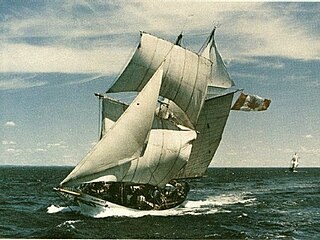
A sailing ship is a sea-going vessel that uses sails mounted on masts to harness the power of wind and propel the vessel. There is a variety of sail plans that propel sailing ships, employing square-rigged or fore-and-aft sails. Some ships carry square sails on each mast—the brig and full-rigged ship, said to be "ship-rigged" when there are three or more masts. Others carry only fore-and-aft sails on each mast, for instance some schooners. Still others employ a combination of square and fore-and-aft sails, including the barque, barquentine, and brigantine.

A sail plan is a description of the specific ways that a sailing craft is rigged. Also, the term "sail plan" is a graphic depiction of the arrangement of the sails for a given sailing craft.

A brigantine is a two-masted sailing vessel with a fully square-rigged foremast and at least two sails on the main mast: a square topsail and a gaff sail mainsail. The main mast is the second and taller of the two masts.

A brig is a type of sailing vessel defined by its rig: two masts which are both square-rigged. Brigs originated in the second half of the 18th century and were a common type of smaller merchant vessel or warship from then until the latter part of the 19th century. In commercial use, they were gradually replaced by fore-and-aft rigged vessels such as schooners, as owners sought to reduce crew costs by having rigs that could be handled by fewer men. In Royal Navy use, brigs were retained for training use when the battle fleets consisted almost entirely of iron-hulled steamships.

A tall ship is a large, traditionally-rigged sailing vessel. Popular modern tall ship rigs include topsail schooners, brigantines, brigs and barques. "Tall ship" can also be defined more specifically by an organization, such as for a race or festival.

A barquentine or schooner barque is a sailing vessel with three or more masts; with a square rigged foremast and fore-and-aft rigged main, mizzen and any other masts.
This is a glossary of nautical terms; some remain current, while many date from the 17th to 19th centuries. See also Wiktionary's nautical terms, Category:Nautical terms, and Nautical metaphors in English. See the Further reading section for additional words and references.

From its modern interpretations to its antecedents when maritime nations would send young naval officer candidates to sea, sail training provides an unconventional and effective way of building many useful skills on and off the water.

Marco Polo was a three-masted wooden clipper ship, launched in 1851 at Saint John, New Brunswick. She was named after Venetian traveler Marco Polo. The ship carried emigrants and passengers to Australia and was the first vessel to make the round trip from Liverpool in under six months. Later in her career, the ship was used as a cargo ship before running aground off Cavendish, Prince Edward Island, in 1883.
Irving McClure Johnson was an American sail training pioneer, adventurer, lecturer and author.

American Pride is a three-masted schooner built in 1941 by Muller Boatworks in Brooklyn, New York. It was administrated by the Children's Maritime Foundation (CMF), her home port is Long Beach, California. She is easily recognized by her bright ochre sails.

STV Pathfinder is a traditionally rigged brigantine formerly operated by Toronto Brigantine Inc., a sail training organization based in Toronto, Ontario, Canada from 1963-2017. Pathfinder, along with her sister ship TS Playfair, operated a youth sail training program during the summer holidays. This program is one of the very few sail training programs where all of the crew except for the captain are youth.

Swift of Ipswich is a topsail schooner owned and operated by the Los Angeles Maritime Institute's TopSail Youth Program as a sail training vessel for at-risk youth.

The brigantine Yankee was a steel hulled schooner, originally constructed by Nordseewerke, Emden, Germany as the Emden, renamed Duhnen, 1919. As Yankee, it became famous as the ship that was used by Irving Johnson and Exy Johnson to circumnavigate the globe four times in eleven years. She appeared on the cover of National Geographic in December 1959.

SS Stella Solaris was an ocean liner built for Messageries Maritimes in 1952. She mainly provided passenger service between France, the Middle East, Southeast Asia, and Japan.
The Irish galley was a vessel in use in the West of Ireland down to the seventeenth century, and was propelled both by oars and sail. In fundamental respects it resembled the Scottish galley or bìrlinn, their mutual ancestor being the Viking longship. Both the Irish and Scottish versions were colloquially known as "longa fada" (longships). The Irish galley was commonly an eight or twelve-oared vessel and was used for both warfare and trade. It was notable for its speed when rowed.
Electa S. "Exy" Johnson was an American author, lecturer, adventure, and sail training pioneer.
The Herreshoff 31, also called the Cat Ketch 31, is an American sailboat that was designed by Halsey Chase Herreshoff as a cruiser and first built in 1979.
This is a list of nautical terms starting with the letter S.
The ETAP 39s is a Belgian sailboat that was designed by Slovenian designers J&J Design, as a cruiser and first built in 1998.














